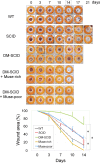Therapeutic Potential of Adipose-Derived SSEA-3-Positive Muse Cells for Treating Diabetic Skin Ulcers
- PMID: 25561682
- PMCID: PMC4303359
- DOI: 10.5966/sctm.2014-0181
Therapeutic Potential of Adipose-Derived SSEA-3-Positive Muse Cells for Treating Diabetic Skin Ulcers
Abstract
Stage-specific embryonic antigen-3 (SSEA-3)-positive multipotent mesenchymal cells (multilineage differentiating stress-enduring [Muse] cells) were isolated from cultured human adipose tissue-derived stem/stromal cells (hASCs) and characterized, and their therapeutic potential for treating diabetic skin ulcers was evaluated. Cultured hASCs were separated using magnetic-activated cell sorting into positive and negative fractions, a SSEA-3+ cell-enriched fraction (Muse-rich) and the remaining fraction (Muse-poor). Muse-rich hASCs showed upregulated and downregulated pluripotency and cell proliferation genes, respectively, compared with Muse-poor hASCs. These cells also released higher amounts of certain growth factors, particularly under hypoxic conditions, compared with Muse-poor cells. Skin ulcers were generated in severe combined immunodeficiency (SCID) mice with type 1 diabetes, which showed delayed wound healing compared with nondiabetic SCID mice. Treatment with Muse-rich cells significantly accelerated wound healing compared with treatment with Muse-poor cells. Transplanted cells were integrated into the regenerated dermis as vascular endothelial cells and other cells. However, they were not detected in the surrounding intact regions. Thus, the selected population of ASCs has greater therapeutic effects to accelerate impaired wound healing associated with type 1 diabetes. These cells can be achieved in large amounts with minimal morbidity and could be a practical tool for a variety of stem cell-depleted or ischemic conditions of various organs and tissues.
Keywords: Adipose; Adult stem cells; Cell culture; Endothelial cell; Hyaluronan; Mesenchymal stem cells; Stem cell transplantation; Tissue regeneration.
©AlphaMed Press.
Figures







Similar articles
-
Therapeutic Potential of Human Adipose-Derived Stem/Stromal Cell Microspheroids Prepared by Three-Dimensional Culture in Non-Cross-Linked Hyaluronic Acid Gel.Stem Cells Transl Med. 2015 Dec;4(12):1511-22. doi: 10.5966/sctm.2015-0037. Epub 2015 Oct 22. Stem Cells Transl Med. 2015. PMID: 26494781 Free PMC article.
-
Muse Cells, a New Type of Pluripotent Stem Cell Derived from Human Fibroblasts.Cell Reprogram. 2016 Apr;18(2):67-77. doi: 10.1089/cell.2015.0085. Cell Reprogram. 2016. PMID: 27055628
-
Diabetes impairs adipose tissue-derived stem cell function and efficiency in promoting wound healing.Wound Repair Regen. 2013 Jul-Aug;21(4):545-53. doi: 10.1111/wrr.12051. Epub 2013 Apr 29. Wound Repair Regen. 2013. PMID: 23627689
-
Muse Cells Provide the Pluripotency of Mesenchymal Stem Cells: Direct Contribution of Muse Cells to Tissue Regeneration.Cell Transplant. 2016;25(5):849-61. doi: 10.3727/096368916X690881. Epub 2016 Feb 15. Cell Transplant. 2016. PMID: 26884346 Review.
-
Regenerative potential of pluripotent nontumorgenetic stem cells: Multilineage differentiating stress enduring cells (Muse cells).Regen Ther. 2020 Jul 27;15:92-96. doi: 10.1016/j.reth.2020.04.011. eCollection 2020 Dec. Regen Ther. 2020. PMID: 33426206 Free PMC article. Review.
Cited by
-
Muse Cells, Nontumorigenic Pluripotent-Like Stem Cells, Have Liver Regeneration Capacity Through Specific Homing and Cell Replacement in a Mouse Model of Liver Fibrosis.Cell Transplant. 2017 May 9;26(5):821-840. doi: 10.3727/096368916X693662. Epub 2016 Nov 2. Cell Transplant. 2017. PMID: 27938474 Free PMC article.
-
The evaluation of the safety and efficacy of intravenously administered allogeneic multilineage-differentiating stress-enduring cells in a swine hepatectomy model.Surg Today. 2021 Apr;51(4):634-650. doi: 10.1007/s00595-020-02117-0. Epub 2020 Sep 11. Surg Today. 2021. PMID: 32915286
-
The secretome of MUSE cells contains factors that may play a role in regulation of stemness, apoptosis and immunomodulation.Cell Cycle. 2017 Jan 2;16(1):33-44. doi: 10.1080/15384101.2016.1211215. Epub 2016 Jul 27. Cell Cycle. 2017. PMID: 27463232 Free PMC article.
-
Therapeutic Potential of Human Adipose-Derived Stem/Stromal Cell Microspheroids Prepared by Three-Dimensional Culture in Non-Cross-Linked Hyaluronic Acid Gel.Stem Cells Transl Med. 2015 Dec;4(12):1511-22. doi: 10.5966/sctm.2015-0037. Epub 2015 Oct 22. Stem Cells Transl Med. 2015. PMID: 26494781 Free PMC article.
-
GelMA loaded with exosomes from human minor salivary gland organoids enhances wound healing by inducing macrophage polarization.J Nanobiotechnology. 2024 Sep 6;22(1):550. doi: 10.1186/s12951-024-02811-y. J Nanobiotechnology. 2024. PMID: 39243057 Free PMC article.
References
-
- Petersen BE, Bowen WC, Patrene KD, et al. Bone marrow as a potential source of hepatic oval cells. Science. 1999;284:1168–1170. - PubMed
-
- Harris RG, Herzog EL, Bruscia EM, et al. Lack of a fusion requirement for development of bone marrow-derived epithelia. Science. 2004;305:90–93. - PubMed
-
- Toma JG, Akhavan M, Fernandes KJ, et al. Isolation of multipotent adult stem cells from the dermis of mammalian skin. Nat Cell Biol. 2001;3:778–784. - PubMed
Publication types
MeSH terms
Substances
LinkOut - more resources
Full Text Sources
Other Literature Sources
Medical
Molecular Biology Databases

